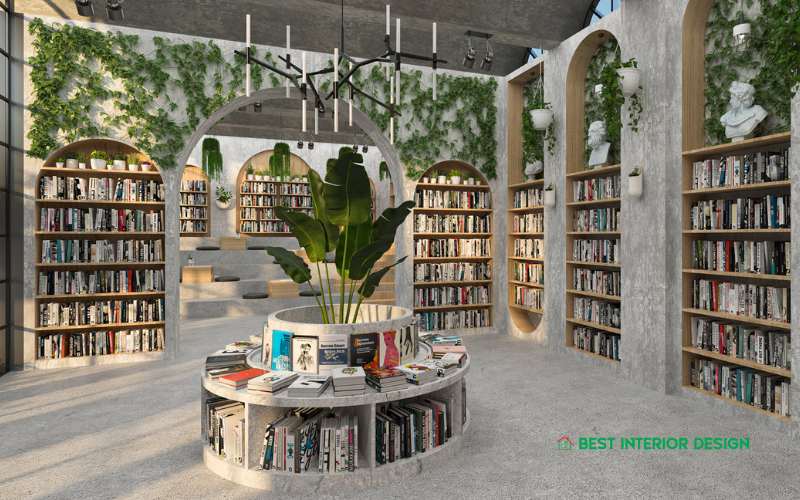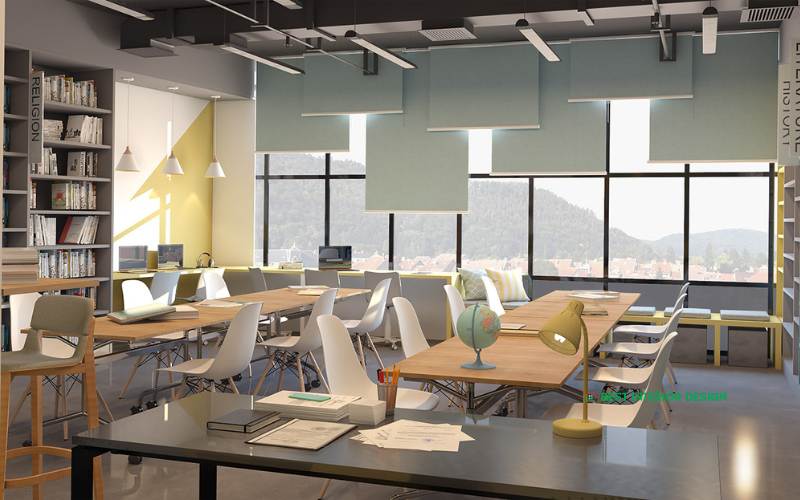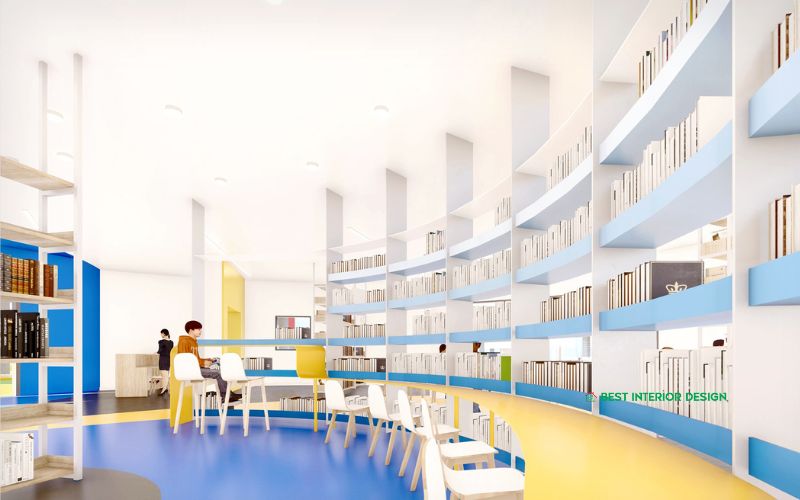Library interior design is an art form that combines functionality and aesthetics to create a space that promotes reading, learning, and community engagement. The design of a library should not only be visually appealing, but also practical, with the goal of making it easy for patrons to find and access the materials they need.
The incorporation of technology and multimedia, along with comfortable seating and study areas, can enhance the user experience and make the library a destination for learning and discovery. With the right design, a library can become a hub of activity and a vital resource for the community.
This blog will provide you with some library interior design strategies that will be helpful.
Lighting Design of Library
The lighting design of a library plays a crucial role in creating a comfortable and functional space for patrons. This can include natural light from windows, as well as artificial lighting from fixtures such as ceiling lights, task lights, and floor lamps.
The design should aim to provide a balance of general lighting, accent lighting, and task lighting to create a visually pleasing and functional environment.
This can be achieved through the use of dimmable lights, automatic lighting controls, and the incorporation of LED lighting which is energy efficient. Proper lighting can also help to improve visibility and safety in the library.
Furniture Selection and Layout
The furniture in a library plays a key role in determining the overall functionality and aesthetic of the space. The selection of furniture should be based on the specific needs of the library’s patrons and the types of activities that will take place in the space.
This can include a variety of seating options, such as chairs, sofas, and benches, as well as tables and desks for studying and working. The layout of the furniture should be designed to create a comfortable and inviting environment that promotes social interaction and collaboration.
It should also allow for easy circulation and accessibility for patrons with disabilities. The furniture should be durable and easy to maintain.
Acoustics and Sound Management
The acoustics of a library play a significant role in creating a comfortable and functional environment for patrons. The design should aim to control the level of ambient noise and echo in the space, while also allowing for sound privacy in designated areas.
This can be achieved through the use of sound-absorbing materials, such as ceiling tiles, carpeting, and wall coverings, as well as the strategic placement of furniture and other elements. Additionally, sound management can include features such as sound masking systems and designated quiet areas. Proper acoustics can also help to improve visibility and safety in the library.
Wayfinding and Circulation:
The wayfinding and circulation design of a library plays a crucial role in making it easy for patrons to navigate the space and find what they need. This can include the use of clear and consistent signage, color-coding, and other visual cues to help patrons orient themselves and find their way around the library.
The layout should be designed to promote natural flow and circulation, with easy access to the different areas of the library, such as the circulation desk, reading areas, study rooms, and other amenities.
The design can also include features such as interactive kiosks, digital directories, and other technology-based tools to help patrons find the resources they need.
Technology Integration in Library
The integration of technology in a library plays a crucial role in providing patrons with access to the resources and information they need.
This can include the use of computers, tablets, and other electronic devices for research and study, as well as the incorporation of digital signage, interactive kiosks, and other technology-based tools to improve the patron experience.
Additionally, technology integration can also include the use of Wi-Fi and other connectivity solutions to allow patrons to access the internet and other online resources while in the library. Furthermore, technology can be used to streamline library operations and make the services more efficient and effective.

Sustainable Design Elements
The incorporation of sustainable design elements in a library can help to reduce the environmental impact of the building, while also promoting a healthy and comfortable environment for patrons.
This can include the use of energy-efficient systems and materials, such as LED lighting, low-flow plumbing fixtures, and high-efficiency HVAC systems.
Additionally, sustainable design can also include the incorporation of natural light, the use of non-toxic and low-VOC materials, and the incorporation of green spaces and landscaping. The sustainable design can also include the strategies to reduce water and energy consumption, recycling and waste management program and promoting active transportation.
Accessibility Considerations
The accessibility design of a library is essential to ensure that the space is usable and inclusive for patrons with disabilities. This can include the use of ramps, elevators, and other accessibility features to ensure that the library is fully accessible for patrons with mobility impairments.
Additionally, the library should also be designed to accommodate the needs of patrons with visual, auditory, and cognitive impairments. This can include the use of large print materials, Braille signage, and assistive listening devices, as well as the incorporation of technology-based tools such as screen readers and text-to-speech software.
The library should also be designed to be easy to navigate for people with different abilities, with clear signage and wayfinding, as well as comfortable and functional seating and other amenities.

Branding and Visual Identity
The branding and visual identity of a library can play a significant role in creating a unique and memorable experience for patrons.
This can include the use of a consistent color palette, typography, and imagery throughout the library, as well as the incorporation of elements such as artwork, sculptures, and other visual features. Additionally, the branding and visual identity can also include the use of digital signage, interactive kiosks, and other technology-based tools to create an immersive and engaging experience for patrons.
The branding can also be incorporated in the library’s logo, promotional materials and the website to create a cohesive image of the library. The branding should be reflective of the library’s mission, values, and community.
Community Engagement and Input
Community engagement and input are essential in the design of a library to ensure that it meets the needs and reflects the values of the community it serves.
This can include the use of surveys, focus groups, and other forms of community outreach to gather feedback and input on the design of the library.
Additionally, community engagement can also include the incorporation of community-specific elements in the design, such as artwork, sculptures, and other visual features that reflect the community’s culture, history, and values. Furthermore, community engagement can also involve the library staff and volunteers in the design process, as well as engaging local artists, architects, and other community members to create a more inclusive and responsive library design.

Maintenance and Durability
The maintenance and durability of a library are essential to ensure that the space remains functional and attractive over time.
This can include the use of durable and low-maintenance materials, such as carpeting, flooring, and wall coverings that are easy to clean and maintain.
Additionally, the design should also include the incorporation of features such as automatic lighting controls, HVAC systems, and other building systems that are easy to access and maintain. The library should also be designed with flexibility in mind, allowing for easy reconfiguration of the space to accommodate changing needs and uses over time.
Furthermore, the design should also include the use of energy-efficient systems and materials to reduce the overall cost of maintenance and energy consumption.
Final Words
In conclusion, library interior design is a complex process that requires careful consideration of a variety of factors to ensure that the space is functional, comfortable, and inclusive for patrons. This includes elements such as lighting design, furniture selection and layout, acoustics and sound management, wayfinding and circulation, technology integration, sustainable design elements, accessibility considerations, branding and visual identity, community engagement and input, and maintenance and durability.
By taking a holistic approach and considering the needs of the community and the specific use of the space, the library design can be optimized to create an environment that promotes learning, engagement, and community.


